Tourism Planning Environment: Coral Bleaching Policy Proposal
VerifiedAdded on 2022/11/04
|16
|4782
|78
Report
AI Summary
This discussion paper, prepared for a Tourism Planning Environment course, focuses on the emerging issue of coral bleaching in Australia, particularly within the context of tourism. The report begins with an executive summary and a positioning statement from Eco Tourism Australia, a non-profit organization dedicated to sustainable tourism. It then provides a detailed background context on coral bleaching, its causes (including scuba diving, snorkeling, boating, fishing, and coastal development), and its devastating effects on the Great Barrier Reef and global marine ecosystems. The paper highlights the statement of need, emphasizing the critical role of coral reefs in marine biodiversity, tourism revenue, and coastal protection, along with their importance to the livelihood of millions of people. The paper proposes the creation of a new tourism plan or policy to address the issue, including the roles of stakeholders, government, and businesses. It discusses potential policy approaches, instruments, and a framework for planning, implementation, and review. The report emphasizes the urgency of the situation and the inadequacy of current measures, advocating for a comprehensive and sustainable tourism plan to mitigate the impact of coral bleaching and preserve the Great Barrier Reef and other coral reefs globally.
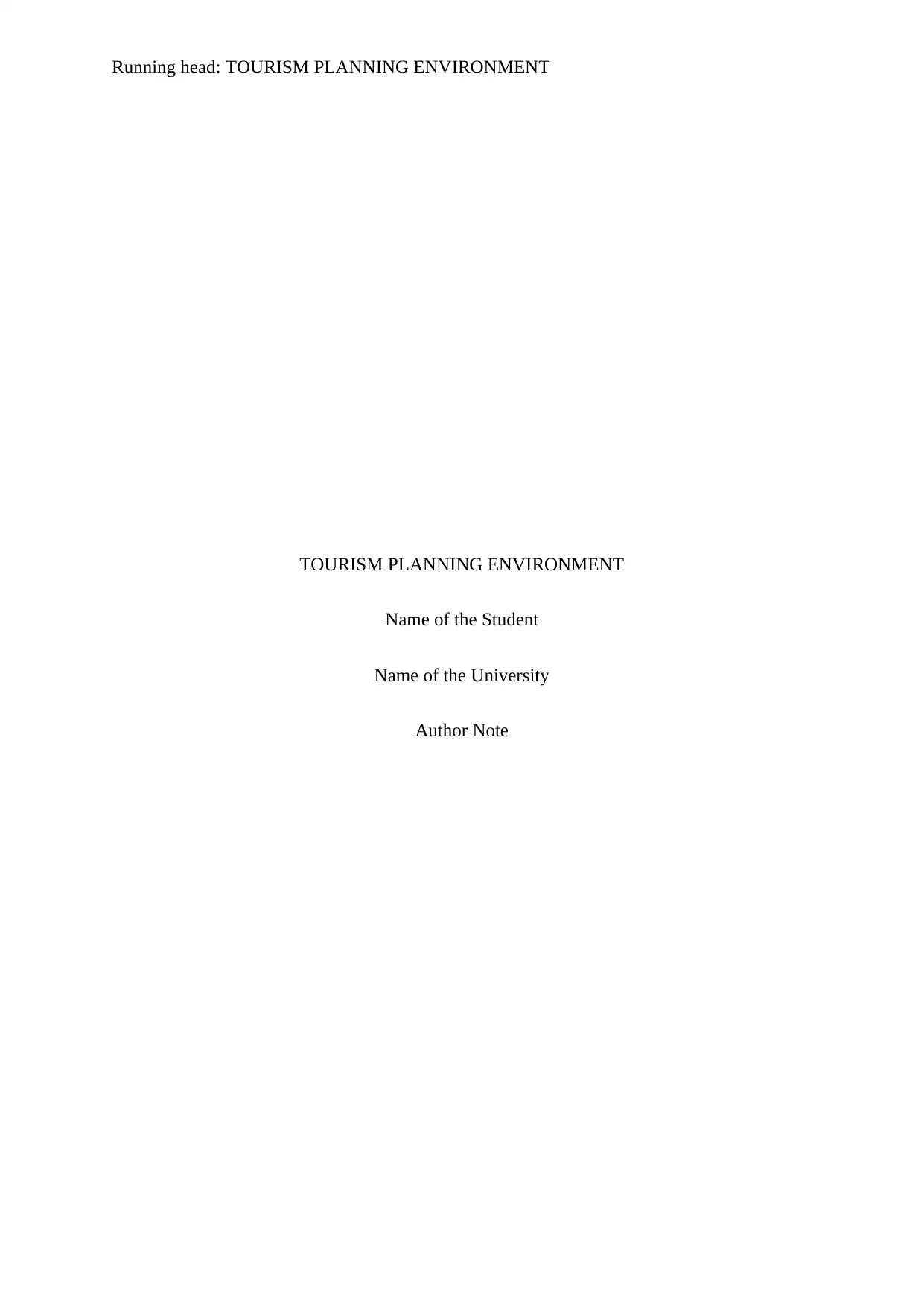
Running head: TOURISM PLANNING ENVIRONMENT
TOURISM PLANNING ENVIRONMENT
Name of the Student
Name of the University
Author Note
TOURISM PLANNING ENVIRONMENT
Name of the Student
Name of the University
Author Note
Paraphrase This Document
Need a fresh take? Get an instant paraphrase of this document with our AI Paraphraser
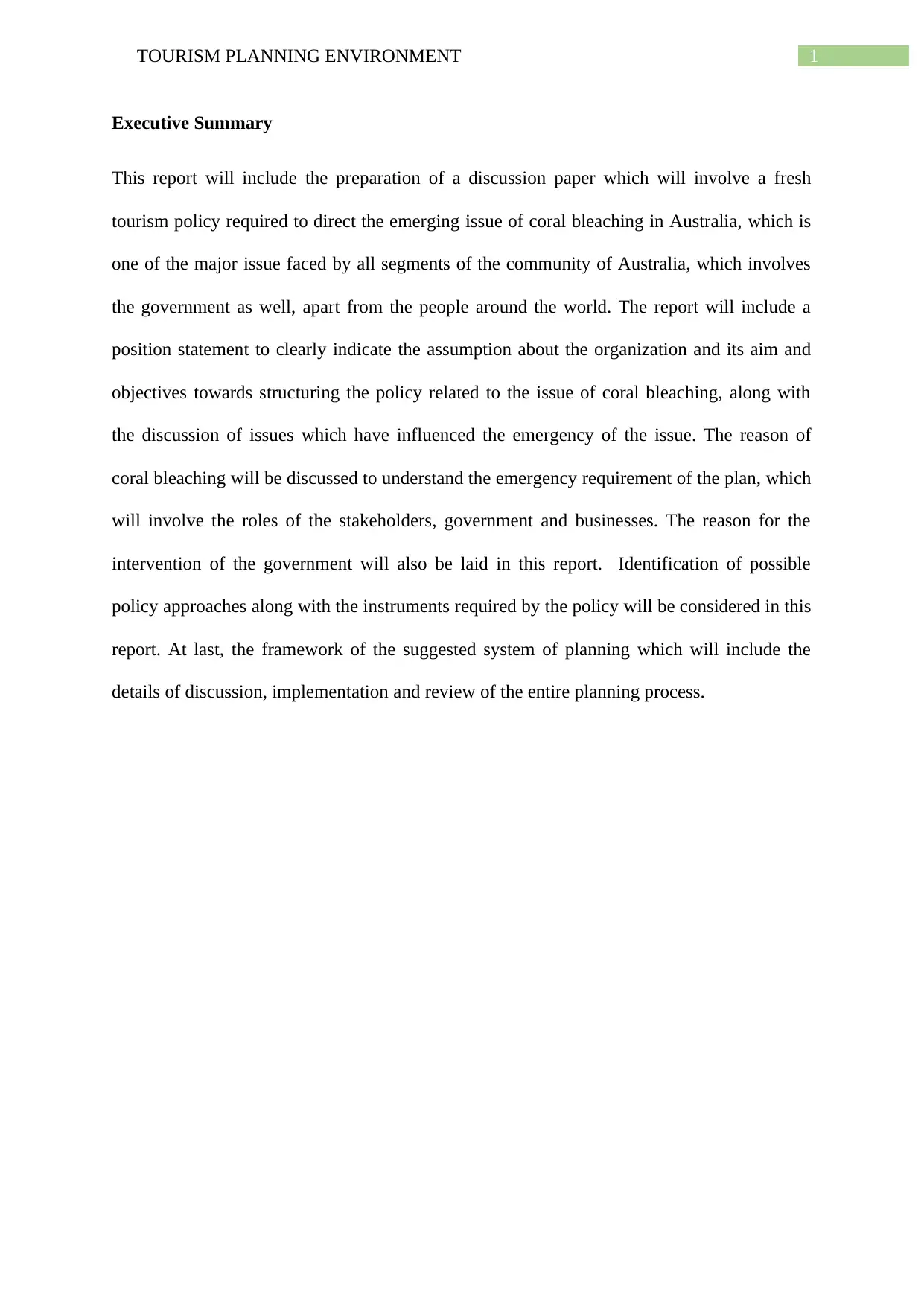
1TOURISM PLANNING ENVIRONMENT
Executive Summary
This report will include the preparation of a discussion paper which will involve a fresh
tourism policy required to direct the emerging issue of coral bleaching in Australia, which is
one of the major issue faced by all segments of the community of Australia, which involves
the government as well, apart from the people around the world. The report will include a
position statement to clearly indicate the assumption about the organization and its aim and
objectives towards structuring the policy related to the issue of coral bleaching, along with
the discussion of issues which have influenced the emergency of the issue. The reason of
coral bleaching will be discussed to understand the emergency requirement of the plan, which
will involve the roles of the stakeholders, government and businesses. The reason for the
intervention of the government will also be laid in this report. Identification of possible
policy approaches along with the instruments required by the policy will be considered in this
report. At last, the framework of the suggested system of planning which will include the
details of discussion, implementation and review of the entire planning process.
Executive Summary
This report will include the preparation of a discussion paper which will involve a fresh
tourism policy required to direct the emerging issue of coral bleaching in Australia, which is
one of the major issue faced by all segments of the community of Australia, which involves
the government as well, apart from the people around the world. The report will include a
position statement to clearly indicate the assumption about the organization and its aim and
objectives towards structuring the policy related to the issue of coral bleaching, along with
the discussion of issues which have influenced the emergency of the issue. The reason of
coral bleaching will be discussed to understand the emergency requirement of the plan, which
will involve the roles of the stakeholders, government and businesses. The reason for the
intervention of the government will also be laid in this report. Identification of possible
policy approaches along with the instruments required by the policy will be considered in this
report. At last, the framework of the suggested system of planning which will include the
details of discussion, implementation and review of the entire planning process.
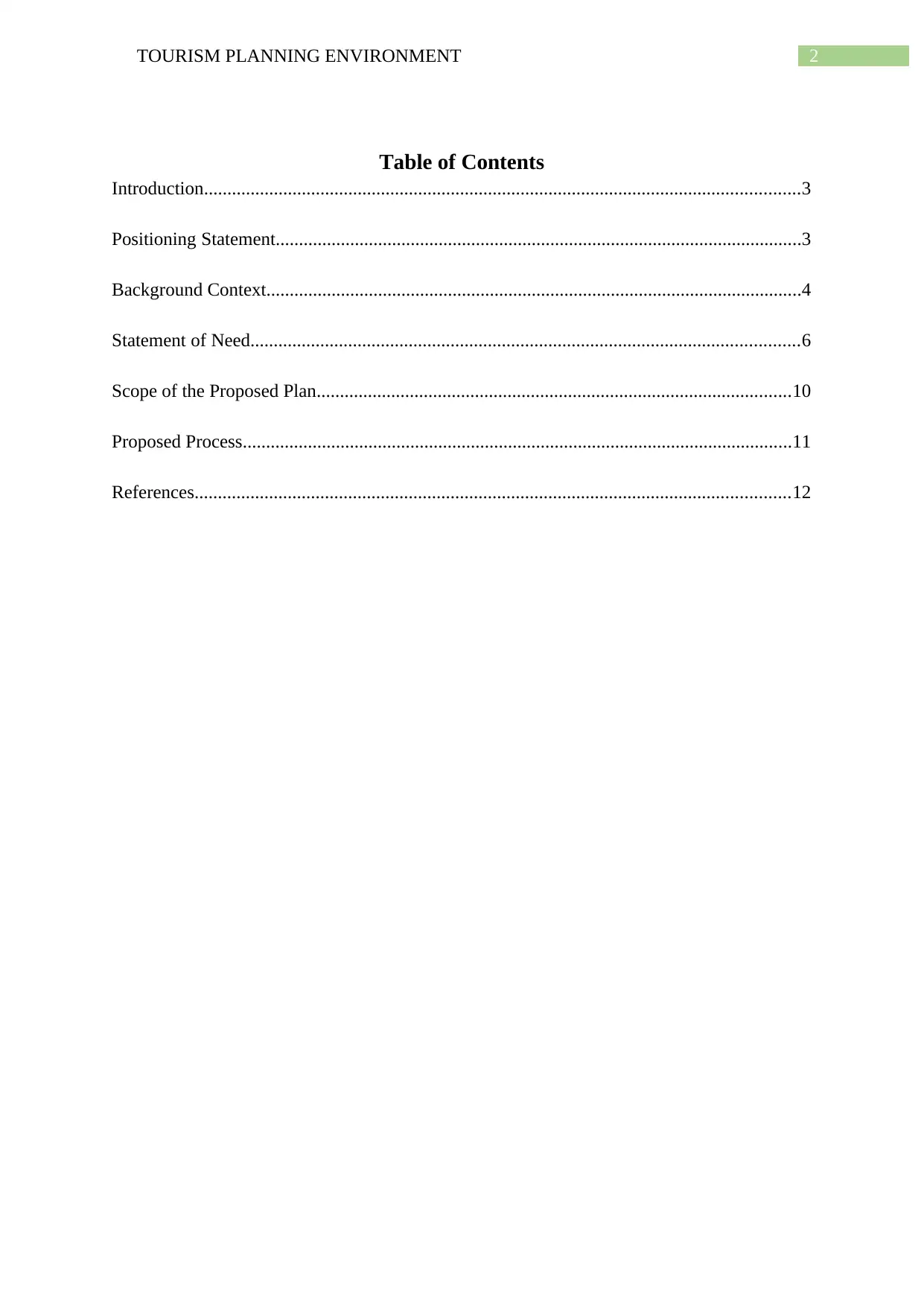
2TOURISM PLANNING ENVIRONMENT
Table of Contents
Introduction................................................................................................................................3
Positioning Statement.................................................................................................................3
Background Context...................................................................................................................4
Statement of Need......................................................................................................................6
Scope of the Proposed Plan......................................................................................................10
Proposed Process......................................................................................................................11
References................................................................................................................................12
Table of Contents
Introduction................................................................................................................................3
Positioning Statement.................................................................................................................3
Background Context...................................................................................................................4
Statement of Need......................................................................................................................6
Scope of the Proposed Plan......................................................................................................10
Proposed Process......................................................................................................................11
References................................................................................................................................12
⊘ This is a preview!⊘
Do you want full access?
Subscribe today to unlock all pages.

Trusted by 1+ million students worldwide
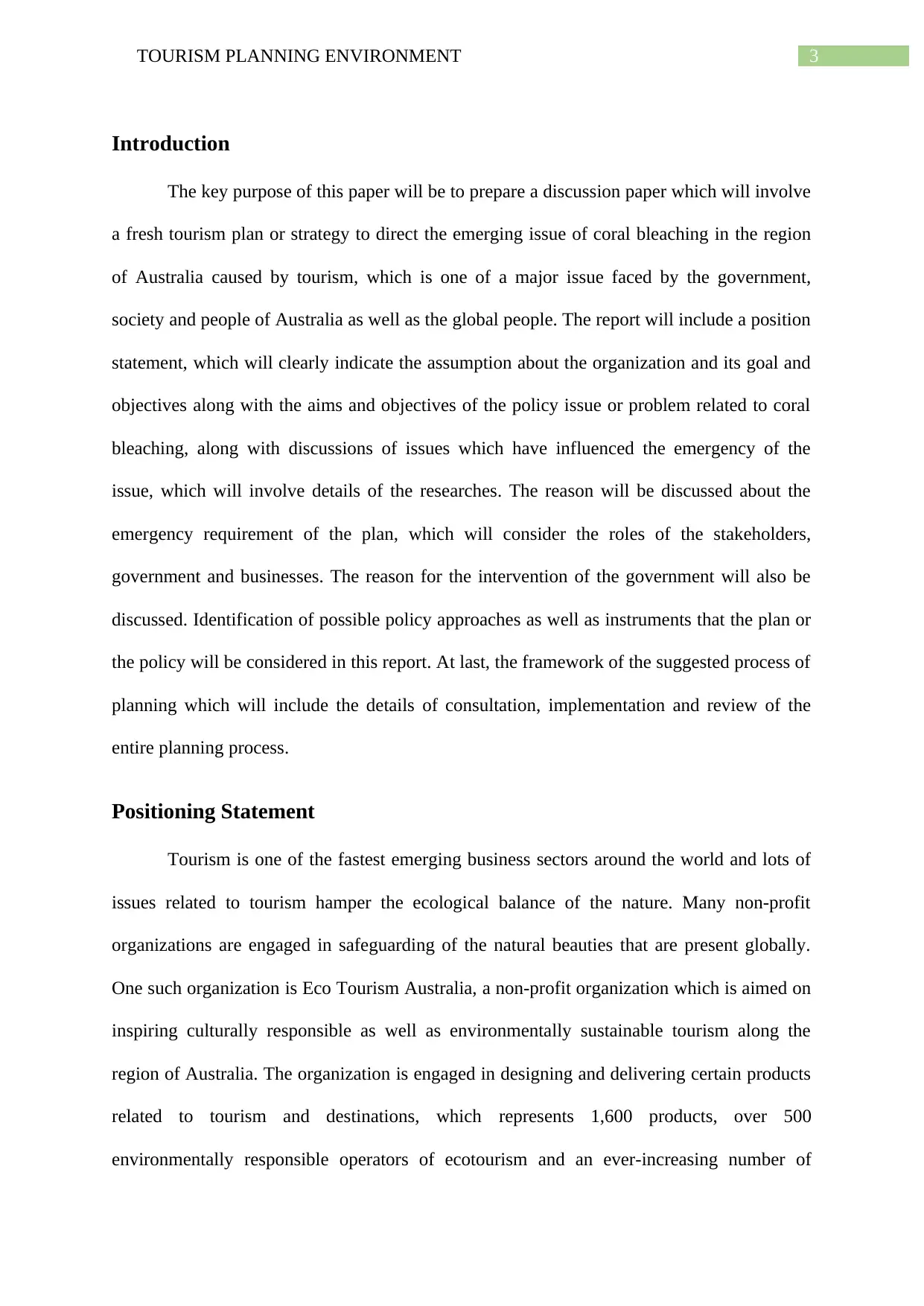
3TOURISM PLANNING ENVIRONMENT
Introduction
The key purpose of this paper will be to prepare a discussion paper which will involve
a fresh tourism plan or strategy to direct the emerging issue of coral bleaching in the region
of Australia caused by tourism, which is one of a major issue faced by the government,
society and people of Australia as well as the global people. The report will include a position
statement, which will clearly indicate the assumption about the organization and its goal and
objectives along with the aims and objectives of the policy issue or problem related to coral
bleaching, along with discussions of issues which have influenced the emergency of the
issue, which will involve details of the researches. The reason will be discussed about the
emergency requirement of the plan, which will consider the roles of the stakeholders,
government and businesses. The reason for the intervention of the government will also be
discussed. Identification of possible policy approaches as well as instruments that the plan or
the policy will be considered in this report. At last, the framework of the suggested process of
planning which will include the details of consultation, implementation and review of the
entire planning process.
Positioning Statement
Tourism is one of the fastest emerging business sectors around the world and lots of
issues related to tourism hamper the ecological balance of the nature. Many non-profit
organizations are engaged in safeguarding of the natural beauties that are present globally.
One such organization is Eco Tourism Australia, a non-profit organization which is aimed on
inspiring culturally responsible as well as environmentally sustainable tourism along the
region of Australia. The organization is engaged in designing and delivering certain products
related to tourism and destinations, which represents 1,600 products, over 500
environmentally responsible operators of ecotourism and an ever-increasing number of
Introduction
The key purpose of this paper will be to prepare a discussion paper which will involve
a fresh tourism plan or strategy to direct the emerging issue of coral bleaching in the region
of Australia caused by tourism, which is one of a major issue faced by the government,
society and people of Australia as well as the global people. The report will include a position
statement, which will clearly indicate the assumption about the organization and its goal and
objectives along with the aims and objectives of the policy issue or problem related to coral
bleaching, along with discussions of issues which have influenced the emergency of the
issue, which will involve details of the researches. The reason will be discussed about the
emergency requirement of the plan, which will consider the roles of the stakeholders,
government and businesses. The reason for the intervention of the government will also be
discussed. Identification of possible policy approaches as well as instruments that the plan or
the policy will be considered in this report. At last, the framework of the suggested process of
planning which will include the details of consultation, implementation and review of the
entire planning process.
Positioning Statement
Tourism is one of the fastest emerging business sectors around the world and lots of
issues related to tourism hamper the ecological balance of the nature. Many non-profit
organizations are engaged in safeguarding of the natural beauties that are present globally.
One such organization is Eco Tourism Australia, a non-profit organization which is aimed on
inspiring culturally responsible as well as environmentally sustainable tourism along the
region of Australia. The organization is engaged in designing and delivering certain products
related to tourism and destinations, which represents 1,600 products, over 500
environmentally responsible operators of ecotourism and an ever-increasing number of
Paraphrase This Document
Need a fresh take? Get an instant paraphrase of this document with our AI Paraphraser
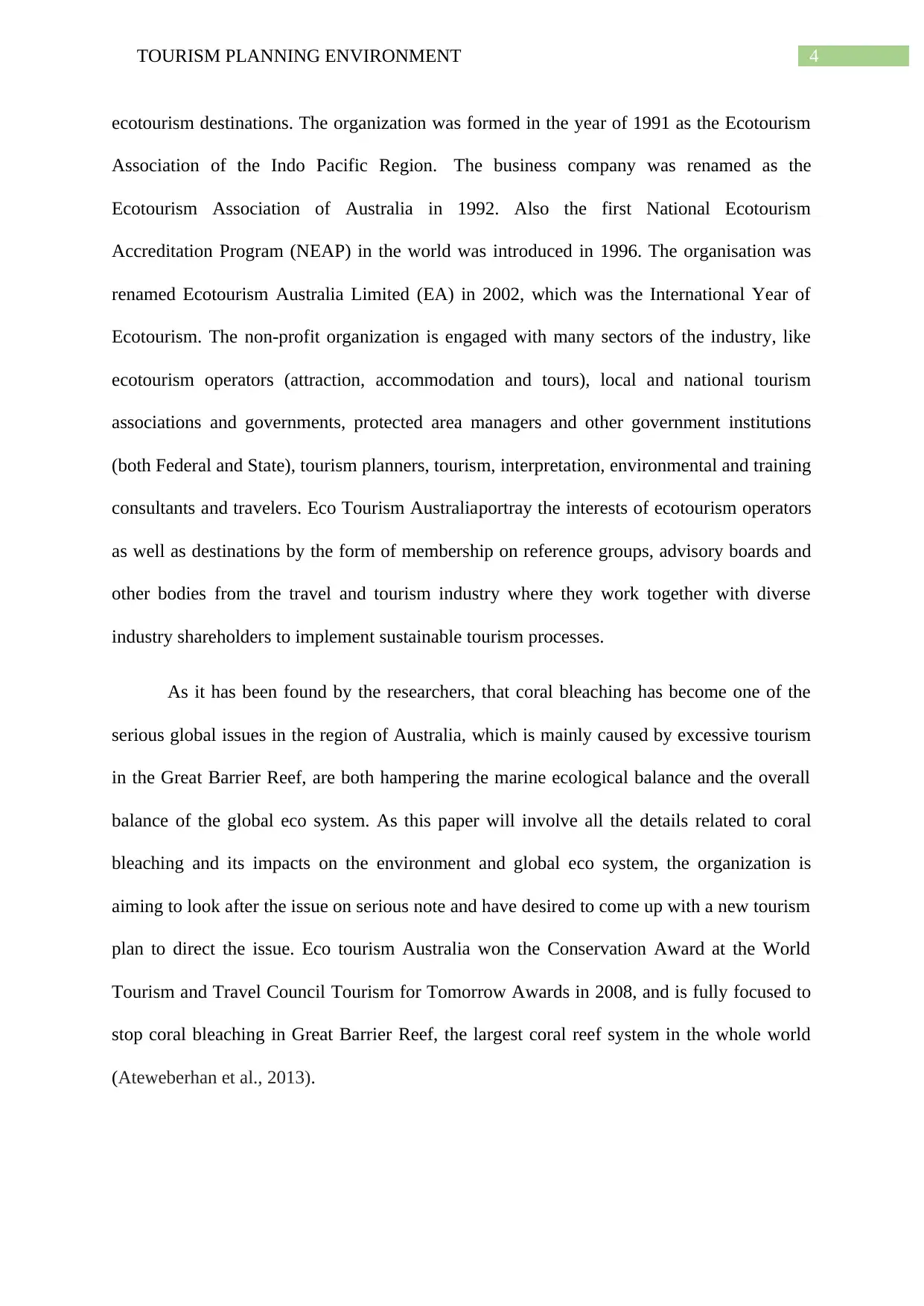
4TOURISM PLANNING ENVIRONMENT
ecotourism destinations. The organization was formed in the year of 1991 as the Ecotourism
Association of the Indo Pacific Region. The business company was renamed as the
Ecotourism Association of Australia in 1992. Also the first National Ecotourism
Accreditation Program (NEAP) in the world was introduced in 1996. The organisation was
renamed Ecotourism Australia Limited (EA) in 2002, which was the International Year of
Ecotourism. The non-profit organization is engaged with many sectors of the industry, like
ecotourism operators (attraction, accommodation and tours), local and national tourism
associations and governments, protected area managers and other government institutions
(both Federal and State), tourism planners, tourism, interpretation, environmental and training
consultants and travelers. Eco Tourism Australiaportray the interests of ecotourism operators
as well as destinations by the form of membership on reference groups, advisory boards and
other bodies from the travel and tourism industry where they work together with diverse
industry shareholders to implement sustainable tourism processes.
As it has been found by the researchers, that coral bleaching has become one of the
serious global issues in the region of Australia, which is mainly caused by excessive tourism
in the Great Barrier Reef, are both hampering the marine ecological balance and the overall
balance of the global eco system. As this paper will involve all the details related to coral
bleaching and its impacts on the environment and global eco system, the organization is
aiming to look after the issue on serious note and have desired to come up with a new tourism
plan to direct the issue. Eco tourism Australia won the Conservation Award at the World
Tourism and Travel Council Tourism for Tomorrow Awards in 2008, and is fully focused to
stop coral bleaching in Great Barrier Reef, the largest coral reef system in the whole world
(Ateweberhan et al., 2013).
ecotourism destinations. The organization was formed in the year of 1991 as the Ecotourism
Association of the Indo Pacific Region. The business company was renamed as the
Ecotourism Association of Australia in 1992. Also the first National Ecotourism
Accreditation Program (NEAP) in the world was introduced in 1996. The organisation was
renamed Ecotourism Australia Limited (EA) in 2002, which was the International Year of
Ecotourism. The non-profit organization is engaged with many sectors of the industry, like
ecotourism operators (attraction, accommodation and tours), local and national tourism
associations and governments, protected area managers and other government institutions
(both Federal and State), tourism planners, tourism, interpretation, environmental and training
consultants and travelers. Eco Tourism Australiaportray the interests of ecotourism operators
as well as destinations by the form of membership on reference groups, advisory boards and
other bodies from the travel and tourism industry where they work together with diverse
industry shareholders to implement sustainable tourism processes.
As it has been found by the researchers, that coral bleaching has become one of the
serious global issues in the region of Australia, which is mainly caused by excessive tourism
in the Great Barrier Reef, are both hampering the marine ecological balance and the overall
balance of the global eco system. As this paper will involve all the details related to coral
bleaching and its impacts on the environment and global eco system, the organization is
aiming to look after the issue on serious note and have desired to come up with a new tourism
plan to direct the issue. Eco tourism Australia won the Conservation Award at the World
Tourism and Travel Council Tourism for Tomorrow Awards in 2008, and is fully focused to
stop coral bleaching in Great Barrier Reef, the largest coral reef system in the whole world
(Ateweberhan et al., 2013).
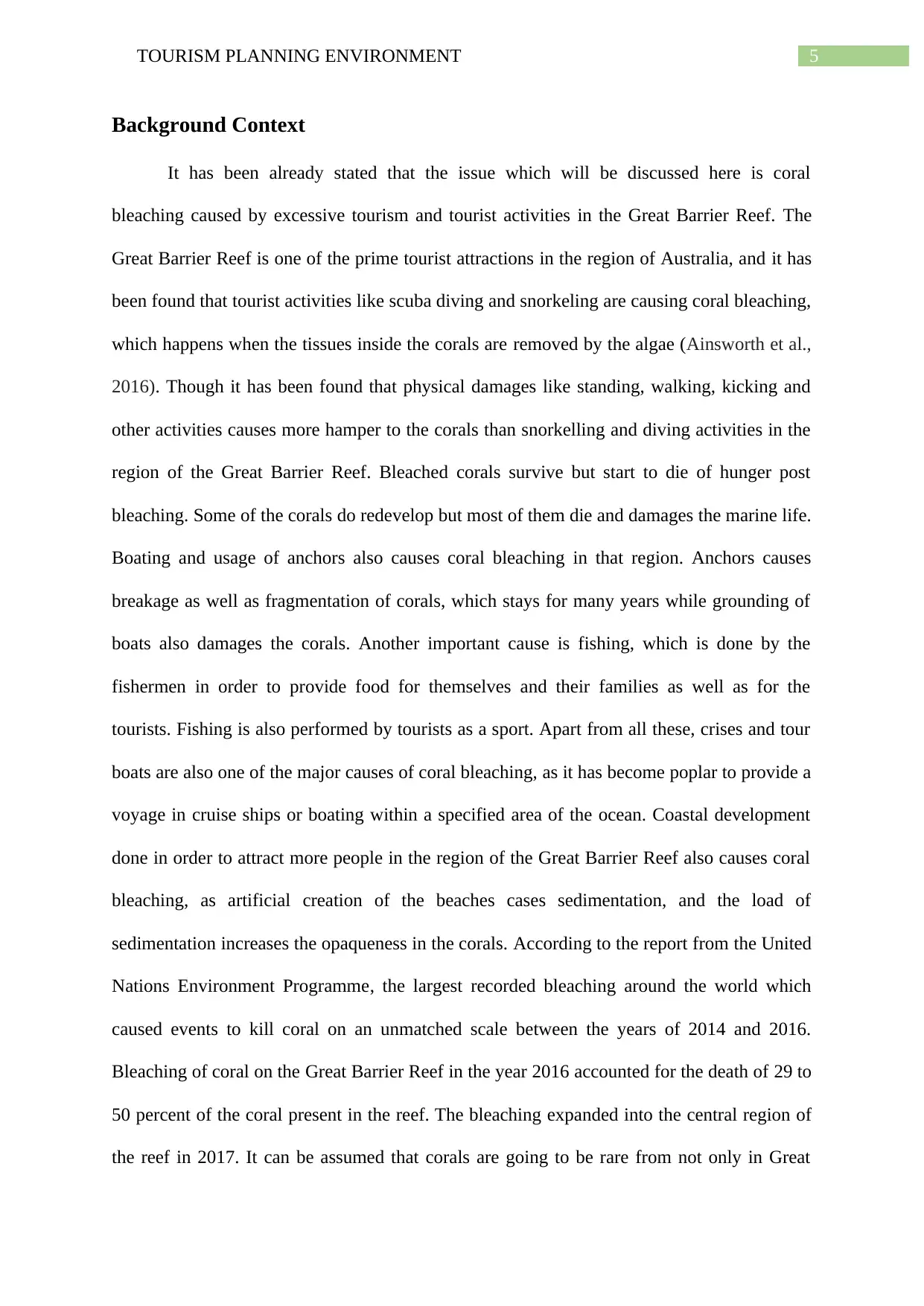
5TOURISM PLANNING ENVIRONMENT
Background Context
It has been already stated that the issue which will be discussed here is coral
bleaching caused by excessive tourism and tourist activities in the Great Barrier Reef. The
Great Barrier Reef is one of the prime tourist attractions in the region of Australia, and it has
been found that tourist activities like scuba diving and snorkeling are causing coral bleaching,
which happens when the tissues inside the corals are removed by the algae (Ainsworth et al.,
2016). Though it has been found that physical damages like standing, walking, kicking and
other activities causes more hamper to the corals than snorkelling and diving activities in the
region of the Great Barrier Reef. Bleached corals survive but start to die of hunger post
bleaching. Some of the corals do redevelop but most of them die and damages the marine life.
Boating and usage of anchors also causes coral bleaching in that region. Anchors causes
breakage as well as fragmentation of corals, which stays for many years while grounding of
boats also damages the corals. Another important cause is fishing, which is done by the
fishermen in order to provide food for themselves and their families as well as for the
tourists. Fishing is also performed by tourists as a sport. Apart from all these, crises and tour
boats are also one of the major causes of coral bleaching, as it has become poplar to provide a
voyage in cruise ships or boating within a specified area of the ocean. Coastal development
done in order to attract more people in the region of the Great Barrier Reef also causes coral
bleaching, as artificial creation of the beaches cases sedimentation, and the load of
sedimentation increases the opaqueness in the corals. According to the report from the United
Nations Environment Programme, the largest recorded bleaching around the world which
caused events to kill coral on an unmatched scale between the years of 2014 and 2016.
Bleaching of coral on the Great Barrier Reef in the year 2016 accounted for the death of 29 to
50 percent of the coral present in the reef. The bleaching expanded into the central region of
the reef in 2017. It can be assumed that corals are going to be rare from not only in Great
Background Context
It has been already stated that the issue which will be discussed here is coral
bleaching caused by excessive tourism and tourist activities in the Great Barrier Reef. The
Great Barrier Reef is one of the prime tourist attractions in the region of Australia, and it has
been found that tourist activities like scuba diving and snorkeling are causing coral bleaching,
which happens when the tissues inside the corals are removed by the algae (Ainsworth et al.,
2016). Though it has been found that physical damages like standing, walking, kicking and
other activities causes more hamper to the corals than snorkelling and diving activities in the
region of the Great Barrier Reef. Bleached corals survive but start to die of hunger post
bleaching. Some of the corals do redevelop but most of them die and damages the marine life.
Boating and usage of anchors also causes coral bleaching in that region. Anchors causes
breakage as well as fragmentation of corals, which stays for many years while grounding of
boats also damages the corals. Another important cause is fishing, which is done by the
fishermen in order to provide food for themselves and their families as well as for the
tourists. Fishing is also performed by tourists as a sport. Apart from all these, crises and tour
boats are also one of the major causes of coral bleaching, as it has become poplar to provide a
voyage in cruise ships or boating within a specified area of the ocean. Coastal development
done in order to attract more people in the region of the Great Barrier Reef also causes coral
bleaching, as artificial creation of the beaches cases sedimentation, and the load of
sedimentation increases the opaqueness in the corals. According to the report from the United
Nations Environment Programme, the largest recorded bleaching around the world which
caused events to kill coral on an unmatched scale between the years of 2014 and 2016.
Bleaching of coral on the Great Barrier Reef in the year 2016 accounted for the death of 29 to
50 percent of the coral present in the reef. The bleaching expanded into the central region of
the reef in 2017. It can be assumed that corals are going to be rare from not only in Great
⊘ This is a preview!⊘
Do you want full access?
Subscribe today to unlock all pages.

Trusted by 1+ million students worldwide
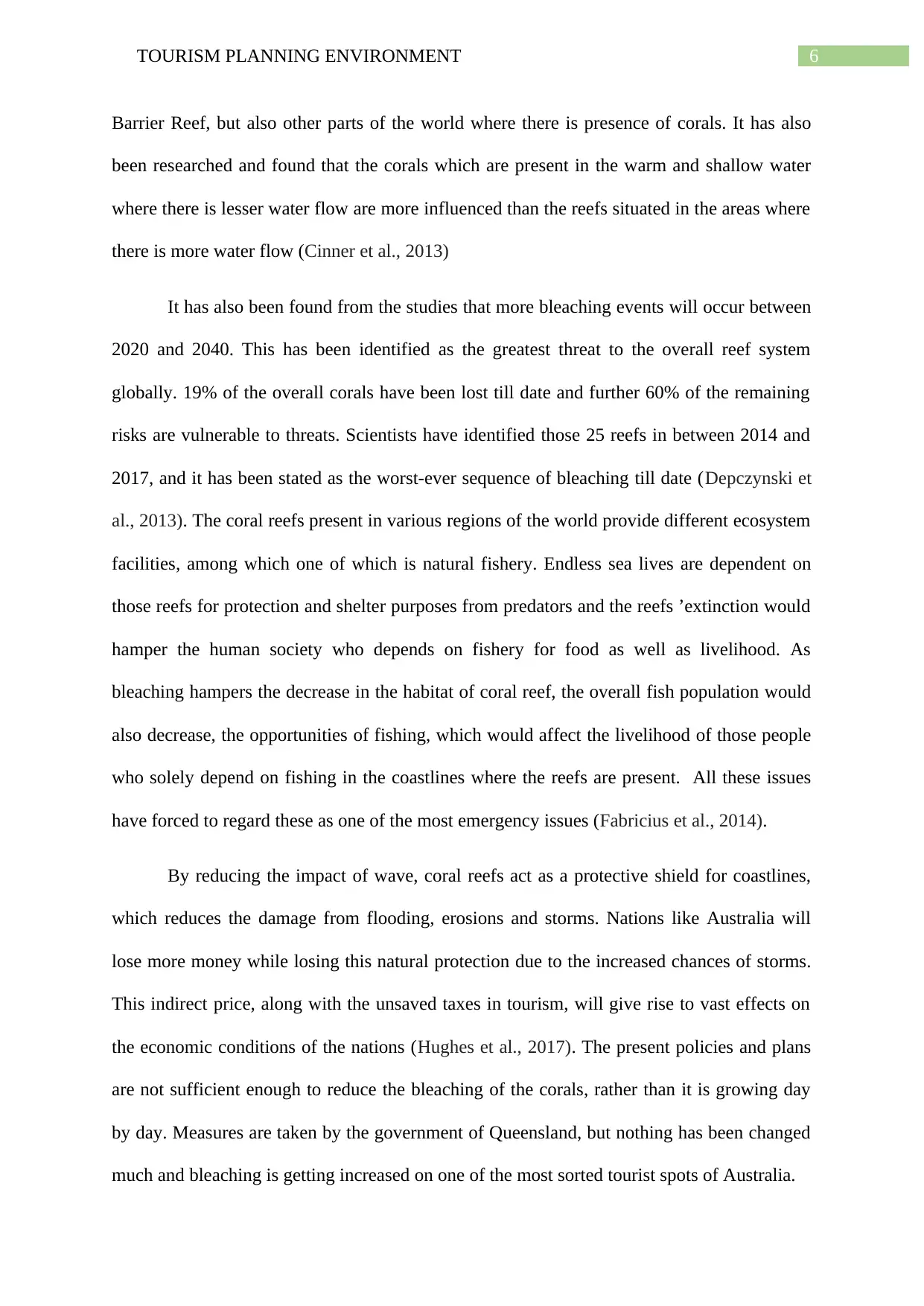
6TOURISM PLANNING ENVIRONMENT
Barrier Reef, but also other parts of the world where there is presence of corals. It has also
been researched and found that the corals which are present in the warm and shallow water
where there is lesser water flow are more influenced than the reefs situated in the areas where
there is more water flow (Cinner et al., 2013)
It has also been found from the studies that more bleaching events will occur between
2020 and 2040. This has been identified as the greatest threat to the overall reef system
globally. 19% of the overall corals have been lost till date and further 60% of the remaining
risks are vulnerable to threats. Scientists have identified those 25 reefs in between 2014 and
2017, and it has been stated as the worst-ever sequence of bleaching till date (Depczynski et
al., 2013). The coral reefs present in various regions of the world provide different ecosystem
facilities, among which one of which is natural fishery. Endless sea lives are dependent on
those reefs for protection and shelter purposes from predators and the reefs ’extinction would
hamper the human society who depends on fishery for food as well as livelihood. As
bleaching hampers the decrease in the habitat of coral reef, the overall fish population would
also decrease, the opportunities of fishing, which would affect the livelihood of those people
who solely depend on fishing in the coastlines where the reefs are present. All these issues
have forced to regard these as one of the most emergency issues (Fabricius et al., 2014).
By reducing the impact of wave, coral reefs act as a protective shield for coastlines,
which reduces the damage from flooding, erosions and storms. Nations like Australia will
lose more money while losing this natural protection due to the increased chances of storms.
This indirect price, along with the unsaved taxes in tourism, will give rise to vast effects on
the economic conditions of the nations (Hughes et al., 2017). The present policies and plans
are not sufficient enough to reduce the bleaching of the corals, rather than it is growing day
by day. Measures are taken by the government of Queensland, but nothing has been changed
much and bleaching is getting increased on one of the most sorted tourist spots of Australia.
Barrier Reef, but also other parts of the world where there is presence of corals. It has also
been researched and found that the corals which are present in the warm and shallow water
where there is lesser water flow are more influenced than the reefs situated in the areas where
there is more water flow (Cinner et al., 2013)
It has also been found from the studies that more bleaching events will occur between
2020 and 2040. This has been identified as the greatest threat to the overall reef system
globally. 19% of the overall corals have been lost till date and further 60% of the remaining
risks are vulnerable to threats. Scientists have identified those 25 reefs in between 2014 and
2017, and it has been stated as the worst-ever sequence of bleaching till date (Depczynski et
al., 2013). The coral reefs present in various regions of the world provide different ecosystem
facilities, among which one of which is natural fishery. Endless sea lives are dependent on
those reefs for protection and shelter purposes from predators and the reefs ’extinction would
hamper the human society who depends on fishery for food as well as livelihood. As
bleaching hampers the decrease in the habitat of coral reef, the overall fish population would
also decrease, the opportunities of fishing, which would affect the livelihood of those people
who solely depend on fishing in the coastlines where the reefs are present. All these issues
have forced to regard these as one of the most emergency issues (Fabricius et al., 2014).
By reducing the impact of wave, coral reefs act as a protective shield for coastlines,
which reduces the damage from flooding, erosions and storms. Nations like Australia will
lose more money while losing this natural protection due to the increased chances of storms.
This indirect price, along with the unsaved taxes in tourism, will give rise to vast effects on
the economic conditions of the nations (Hughes et al., 2017). The present policies and plans
are not sufficient enough to reduce the bleaching of the corals, rather than it is growing day
by day. Measures are taken by the government of Queensland, but nothing has been changed
much and bleaching is getting increased on one of the most sorted tourist spots of Australia.
Paraphrase This Document
Need a fresh take? Get an instant paraphrase of this document with our AI Paraphraser
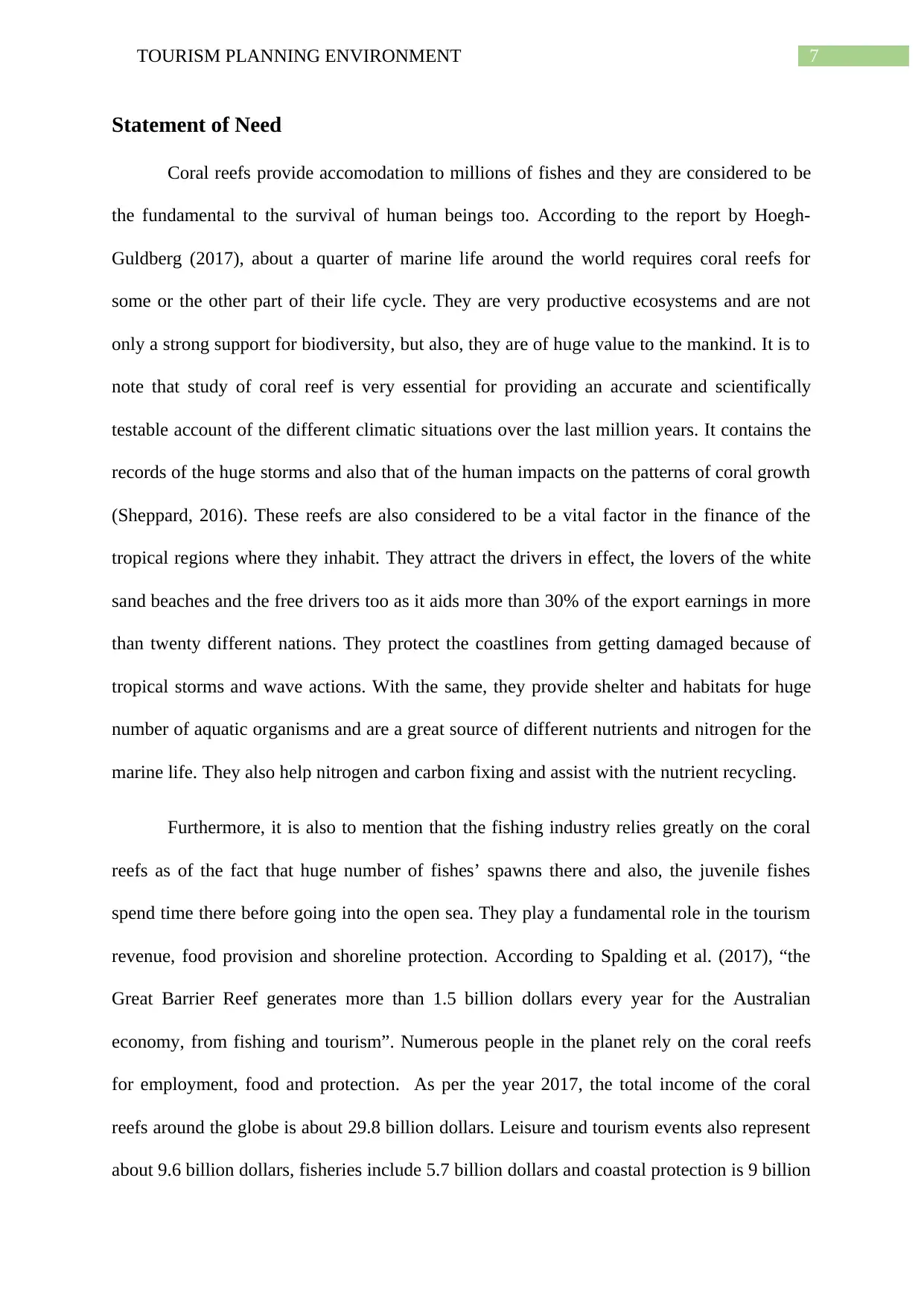
7TOURISM PLANNING ENVIRONMENT
Statement of Need
Coral reefs provide accomodation to millions of fishes and they are considered to be
the fundamental to the survival of human beings too. According to the report by Hoegh-
Guldberg (2017), about a quarter of marine life around the world requires coral reefs for
some or the other part of their life cycle. They are very productive ecosystems and are not
only a strong support for biodiversity, but also, they are of huge value to the mankind. It is to
note that study of coral reef is very essential for providing an accurate and scientifically
testable account of the different climatic situations over the last million years. It contains the
records of the huge storms and also that of the human impacts on the patterns of coral growth
(Sheppard, 2016). These reefs are also considered to be a vital factor in the finance of the
tropical regions where they inhabit. They attract the drivers in effect, the lovers of the white
sand beaches and the free drivers too as it aids more than 30% of the export earnings in more
than twenty different nations. They protect the coastlines from getting damaged because of
tropical storms and wave actions. With the same, they provide shelter and habitats for huge
number of aquatic organisms and are a great source of different nutrients and nitrogen for the
marine life. They also help nitrogen and carbon fixing and assist with the nutrient recycling.
Furthermore, it is also to mention that the fishing industry relies greatly on the coral
reefs as of the fact that huge number of fishes’ spawns there and also, the juvenile fishes
spend time there before going into the open sea. They play a fundamental role in the tourism
revenue, food provision and shoreline protection. According to Spalding et al. (2017), “the
Great Barrier Reef generates more than 1.5 billion dollars every year for the Australian
economy, from fishing and tourism”. Numerous people in the planet rely on the coral reefs
for employment, food and protection. As per the year 2017, the total income of the coral
reefs around the globe is about 29.8 billion dollars. Leisure and tourism events also represent
about 9.6 billion dollars, fisheries include 5.7 billion dollars and coastal protection is 9 billion
Statement of Need
Coral reefs provide accomodation to millions of fishes and they are considered to be
the fundamental to the survival of human beings too. According to the report by Hoegh-
Guldberg (2017), about a quarter of marine life around the world requires coral reefs for
some or the other part of their life cycle. They are very productive ecosystems and are not
only a strong support for biodiversity, but also, they are of huge value to the mankind. It is to
note that study of coral reef is very essential for providing an accurate and scientifically
testable account of the different climatic situations over the last million years. It contains the
records of the huge storms and also that of the human impacts on the patterns of coral growth
(Sheppard, 2016). These reefs are also considered to be a vital factor in the finance of the
tropical regions where they inhabit. They attract the drivers in effect, the lovers of the white
sand beaches and the free drivers too as it aids more than 30% of the export earnings in more
than twenty different nations. They protect the coastlines from getting damaged because of
tropical storms and wave actions. With the same, they provide shelter and habitats for huge
number of aquatic organisms and are a great source of different nutrients and nitrogen for the
marine life. They also help nitrogen and carbon fixing and assist with the nutrient recycling.
Furthermore, it is also to mention that the fishing industry relies greatly on the coral
reefs as of the fact that huge number of fishes’ spawns there and also, the juvenile fishes
spend time there before going into the open sea. They play a fundamental role in the tourism
revenue, food provision and shoreline protection. According to Spalding et al. (2017), “the
Great Barrier Reef generates more than 1.5 billion dollars every year for the Australian
economy, from fishing and tourism”. Numerous people in the planet rely on the coral reefs
for employment, food and protection. As per the year 2017, the total income of the coral
reefs around the globe is about 29.8 billion dollars. Leisure and tourism events also represent
about 9.6 billion dollars, fisheries include 5.7 billion dollars and coastal protection is 9 billion
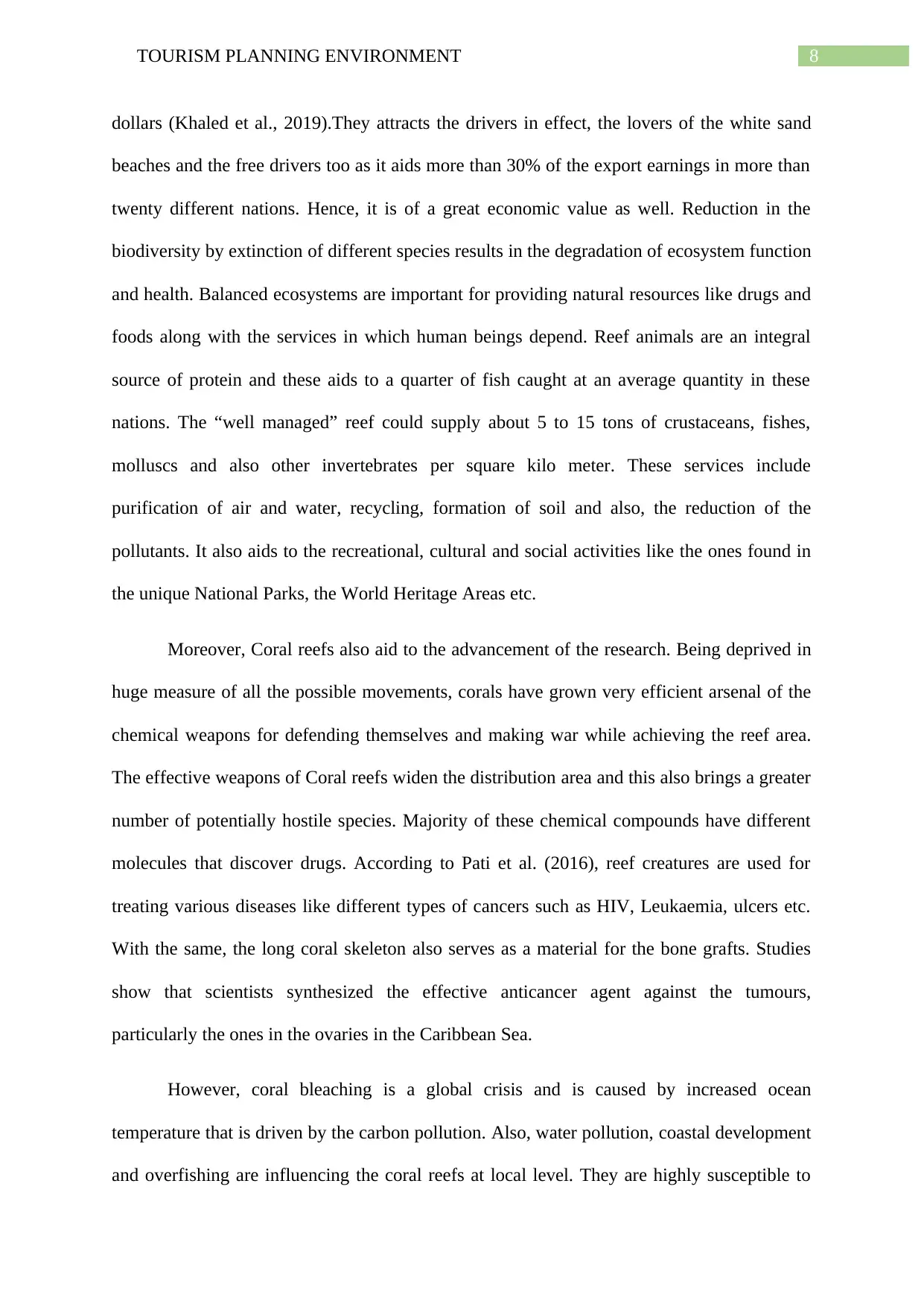
8TOURISM PLANNING ENVIRONMENT
dollars (Khaled et al., 2019).They attracts the drivers in effect, the lovers of the white sand
beaches and the free drivers too as it aids more than 30% of the export earnings in more than
twenty different nations. Hence, it is of a great economic value as well. Reduction in the
biodiversity by extinction of different species results in the degradation of ecosystem function
and health. Balanced ecosystems are important for providing natural resources like drugs and
foods along with the services in which human beings depend. Reef animals are an integral
source of protein and these aids to a quarter of fish caught at an average quantity in these
nations. The “well managed” reef could supply about 5 to 15 tons of crustaceans, fishes,
molluscs and also other invertebrates per square kilo meter. These services include
purification of air and water, recycling, formation of soil and also, the reduction of the
pollutants. It also aids to the recreational, cultural and social activities like the ones found in
the unique National Parks, the World Heritage Areas etc.
Moreover, Coral reefs also aid to the advancement of the research. Being deprived in
huge measure of all the possible movements, corals have grown very efficient arsenal of the
chemical weapons for defending themselves and making war while achieving the reef area.
The effective weapons of Coral reefs widen the distribution area and this also brings a greater
number of potentially hostile species. Majority of these chemical compounds have different
molecules that discover drugs. According to Pati et al. (2016), reef creatures are used for
treating various diseases like different types of cancers such as HIV, Leukaemia, ulcers etc.
With the same, the long coral skeleton also serves as a material for the bone grafts. Studies
show that scientists synthesized the effective anticancer agent against the tumours,
particularly the ones in the ovaries in the Caribbean Sea.
However, coral bleaching is a global crisis and is caused by increased ocean
temperature that is driven by the carbon pollution. Also, water pollution, coastal development
and overfishing are influencing the coral reefs at local level. They are highly susceptible to
dollars (Khaled et al., 2019).They attracts the drivers in effect, the lovers of the white sand
beaches and the free drivers too as it aids more than 30% of the export earnings in more than
twenty different nations. Hence, it is of a great economic value as well. Reduction in the
biodiversity by extinction of different species results in the degradation of ecosystem function
and health. Balanced ecosystems are important for providing natural resources like drugs and
foods along with the services in which human beings depend. Reef animals are an integral
source of protein and these aids to a quarter of fish caught at an average quantity in these
nations. The “well managed” reef could supply about 5 to 15 tons of crustaceans, fishes,
molluscs and also other invertebrates per square kilo meter. These services include
purification of air and water, recycling, formation of soil and also, the reduction of the
pollutants. It also aids to the recreational, cultural and social activities like the ones found in
the unique National Parks, the World Heritage Areas etc.
Moreover, Coral reefs also aid to the advancement of the research. Being deprived in
huge measure of all the possible movements, corals have grown very efficient arsenal of the
chemical weapons for defending themselves and making war while achieving the reef area.
The effective weapons of Coral reefs widen the distribution area and this also brings a greater
number of potentially hostile species. Majority of these chemical compounds have different
molecules that discover drugs. According to Pati et al. (2016), reef creatures are used for
treating various diseases like different types of cancers such as HIV, Leukaemia, ulcers etc.
With the same, the long coral skeleton also serves as a material for the bone grafts. Studies
show that scientists synthesized the effective anticancer agent against the tumours,
particularly the ones in the ovaries in the Caribbean Sea.
However, coral bleaching is a global crisis and is caused by increased ocean
temperature that is driven by the carbon pollution. Also, water pollution, coastal development
and overfishing are influencing the coral reefs at local level. They are highly susceptible to
⊘ This is a preview!⊘
Do you want full access?
Subscribe today to unlock all pages.

Trusted by 1+ million students worldwide
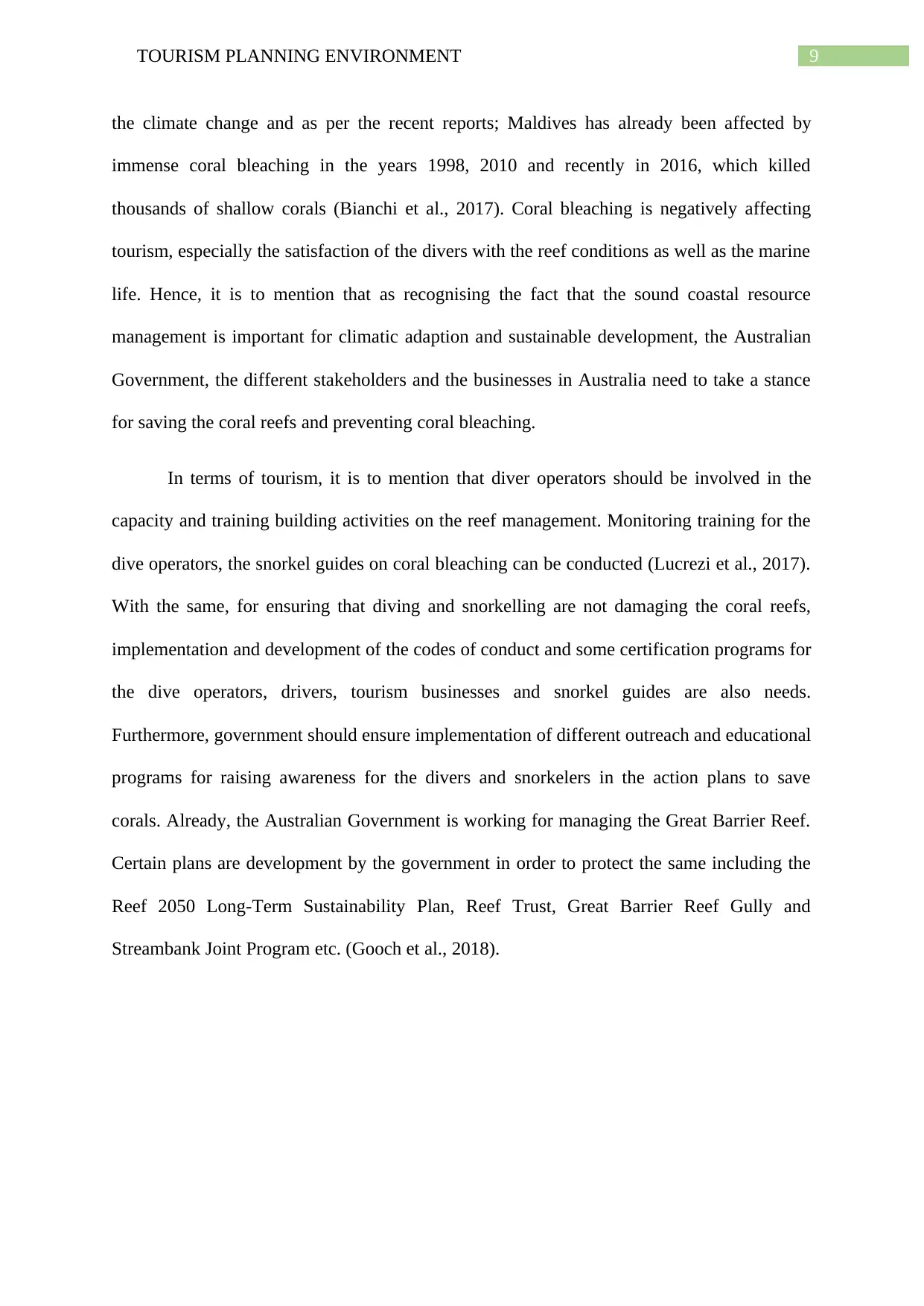
9TOURISM PLANNING ENVIRONMENT
the climate change and as per the recent reports; Maldives has already been affected by
immense coral bleaching in the years 1998, 2010 and recently in 2016, which killed
thousands of shallow corals (Bianchi et al., 2017). Coral bleaching is negatively affecting
tourism, especially the satisfaction of the divers with the reef conditions as well as the marine
life. Hence, it is to mention that as recognising the fact that the sound coastal resource
management is important for climatic adaption and sustainable development, the Australian
Government, the different stakeholders and the businesses in Australia need to take a stance
for saving the coral reefs and preventing coral bleaching.
In terms of tourism, it is to mention that diver operators should be involved in the
capacity and training building activities on the reef management. Monitoring training for the
dive operators, the snorkel guides on coral bleaching can be conducted (Lucrezi et al., 2017).
With the same, for ensuring that diving and snorkelling are not damaging the coral reefs,
implementation and development of the codes of conduct and some certification programs for
the dive operators, drivers, tourism businesses and snorkel guides are also needs.
Furthermore, government should ensure implementation of different outreach and educational
programs for raising awareness for the divers and snorkelers in the action plans to save
corals. Already, the Australian Government is working for managing the Great Barrier Reef.
Certain plans are development by the government in order to protect the same including the
Reef 2050 Long-Term Sustainability Plan, Reef Trust, Great Barrier Reef Gully and
Streambank Joint Program etc. (Gooch et al., 2018).
the climate change and as per the recent reports; Maldives has already been affected by
immense coral bleaching in the years 1998, 2010 and recently in 2016, which killed
thousands of shallow corals (Bianchi et al., 2017). Coral bleaching is negatively affecting
tourism, especially the satisfaction of the divers with the reef conditions as well as the marine
life. Hence, it is to mention that as recognising the fact that the sound coastal resource
management is important for climatic adaption and sustainable development, the Australian
Government, the different stakeholders and the businesses in Australia need to take a stance
for saving the coral reefs and preventing coral bleaching.
In terms of tourism, it is to mention that diver operators should be involved in the
capacity and training building activities on the reef management. Monitoring training for the
dive operators, the snorkel guides on coral bleaching can be conducted (Lucrezi et al., 2017).
With the same, for ensuring that diving and snorkelling are not damaging the coral reefs,
implementation and development of the codes of conduct and some certification programs for
the dive operators, drivers, tourism businesses and snorkel guides are also needs.
Furthermore, government should ensure implementation of different outreach and educational
programs for raising awareness for the divers and snorkelers in the action plans to save
corals. Already, the Australian Government is working for managing the Great Barrier Reef.
Certain plans are development by the government in order to protect the same including the
Reef 2050 Long-Term Sustainability Plan, Reef Trust, Great Barrier Reef Gully and
Streambank Joint Program etc. (Gooch et al., 2018).
Paraphrase This Document
Need a fresh take? Get an instant paraphrase of this document with our AI Paraphraser
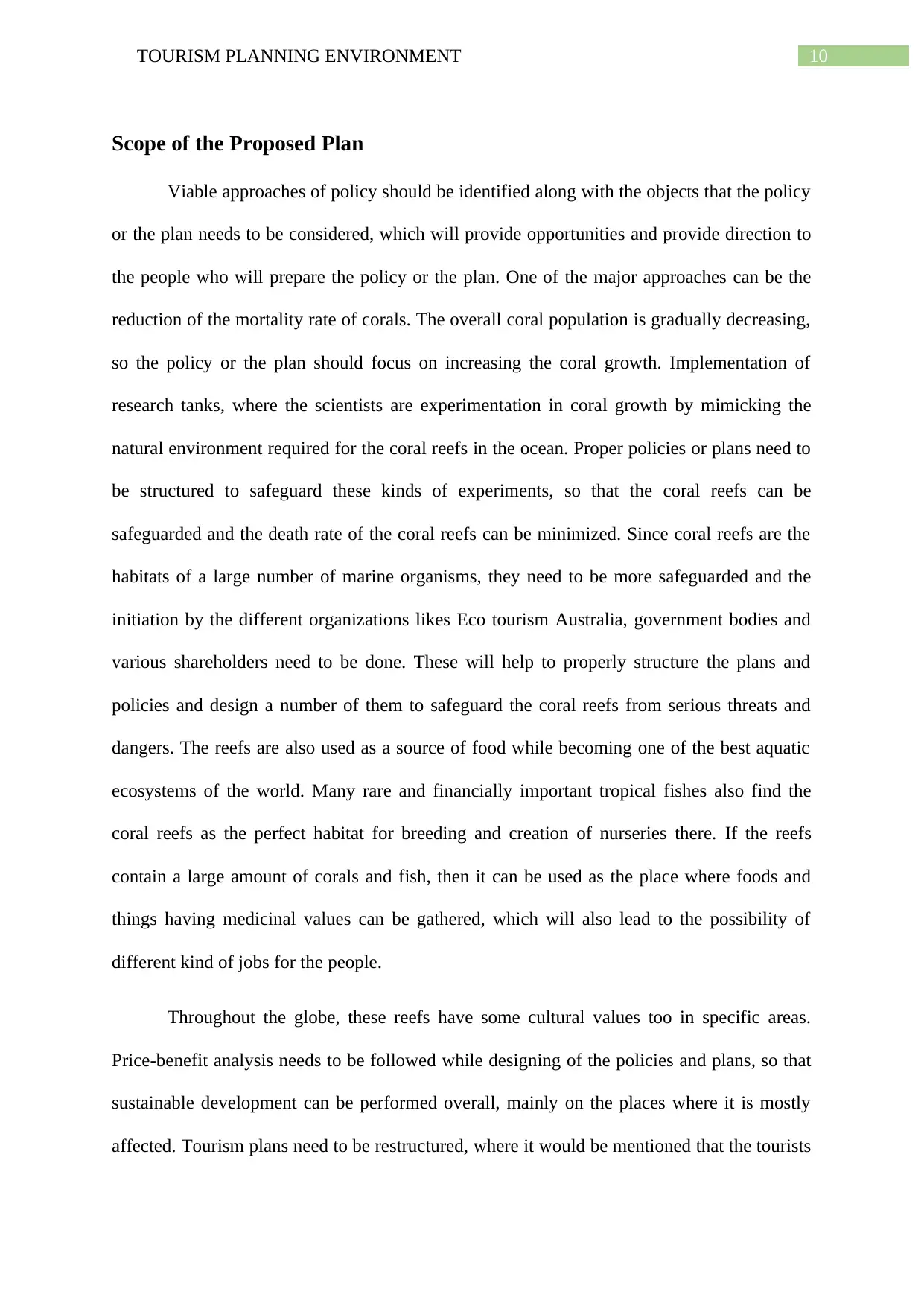
10TOURISM PLANNING ENVIRONMENT
Scope of the Proposed Plan
Viable approaches of policy should be identified along with the objects that the policy
or the plan needs to be considered, which will provide opportunities and provide direction to
the people who will prepare the policy or the plan. One of the major approaches can be the
reduction of the mortality rate of corals. The overall coral population is gradually decreasing,
so the policy or the plan should focus on increasing the coral growth. Implementation of
research tanks, where the scientists are experimentation in coral growth by mimicking the
natural environment required for the coral reefs in the ocean. Proper policies or plans need to
be structured to safeguard these kinds of experiments, so that the coral reefs can be
safeguarded and the death rate of the coral reefs can be minimized. Since coral reefs are the
habitats of a large number of marine organisms, they need to be more safeguarded and the
initiation by the different organizations likes Eco tourism Australia, government bodies and
various shareholders need to be done. These will help to properly structure the plans and
policies and design a number of them to safeguard the coral reefs from serious threats and
dangers. The reefs are also used as a source of food while becoming one of the best aquatic
ecosystems of the world. Many rare and financially important tropical fishes also find the
coral reefs as the perfect habitat for breeding and creation of nurseries there. If the reefs
contain a large amount of corals and fish, then it can be used as the place where foods and
things having medicinal values can be gathered, which will also lead to the possibility of
different kind of jobs for the people.
Throughout the globe, these reefs have some cultural values too in specific areas.
Price-benefit analysis needs to be followed while designing of the policies and plans, so that
sustainable development can be performed overall, mainly on the places where it is mostly
affected. Tourism plans need to be restructured, where it would be mentioned that the tourists
Scope of the Proposed Plan
Viable approaches of policy should be identified along with the objects that the policy
or the plan needs to be considered, which will provide opportunities and provide direction to
the people who will prepare the policy or the plan. One of the major approaches can be the
reduction of the mortality rate of corals. The overall coral population is gradually decreasing,
so the policy or the plan should focus on increasing the coral growth. Implementation of
research tanks, where the scientists are experimentation in coral growth by mimicking the
natural environment required for the coral reefs in the ocean. Proper policies or plans need to
be structured to safeguard these kinds of experiments, so that the coral reefs can be
safeguarded and the death rate of the coral reefs can be minimized. Since coral reefs are the
habitats of a large number of marine organisms, they need to be more safeguarded and the
initiation by the different organizations likes Eco tourism Australia, government bodies and
various shareholders need to be done. These will help to properly structure the plans and
policies and design a number of them to safeguard the coral reefs from serious threats and
dangers. The reefs are also used as a source of food while becoming one of the best aquatic
ecosystems of the world. Many rare and financially important tropical fishes also find the
coral reefs as the perfect habitat for breeding and creation of nurseries there. If the reefs
contain a large amount of corals and fish, then it can be used as the place where foods and
things having medicinal values can be gathered, which will also lead to the possibility of
different kind of jobs for the people.
Throughout the globe, these reefs have some cultural values too in specific areas.
Price-benefit analysis needs to be followed while designing of the policies and plans, so that
sustainable development can be performed overall, mainly on the places where it is mostly
affected. Tourism plans need to be restructured, where it would be mentioned that the tourists
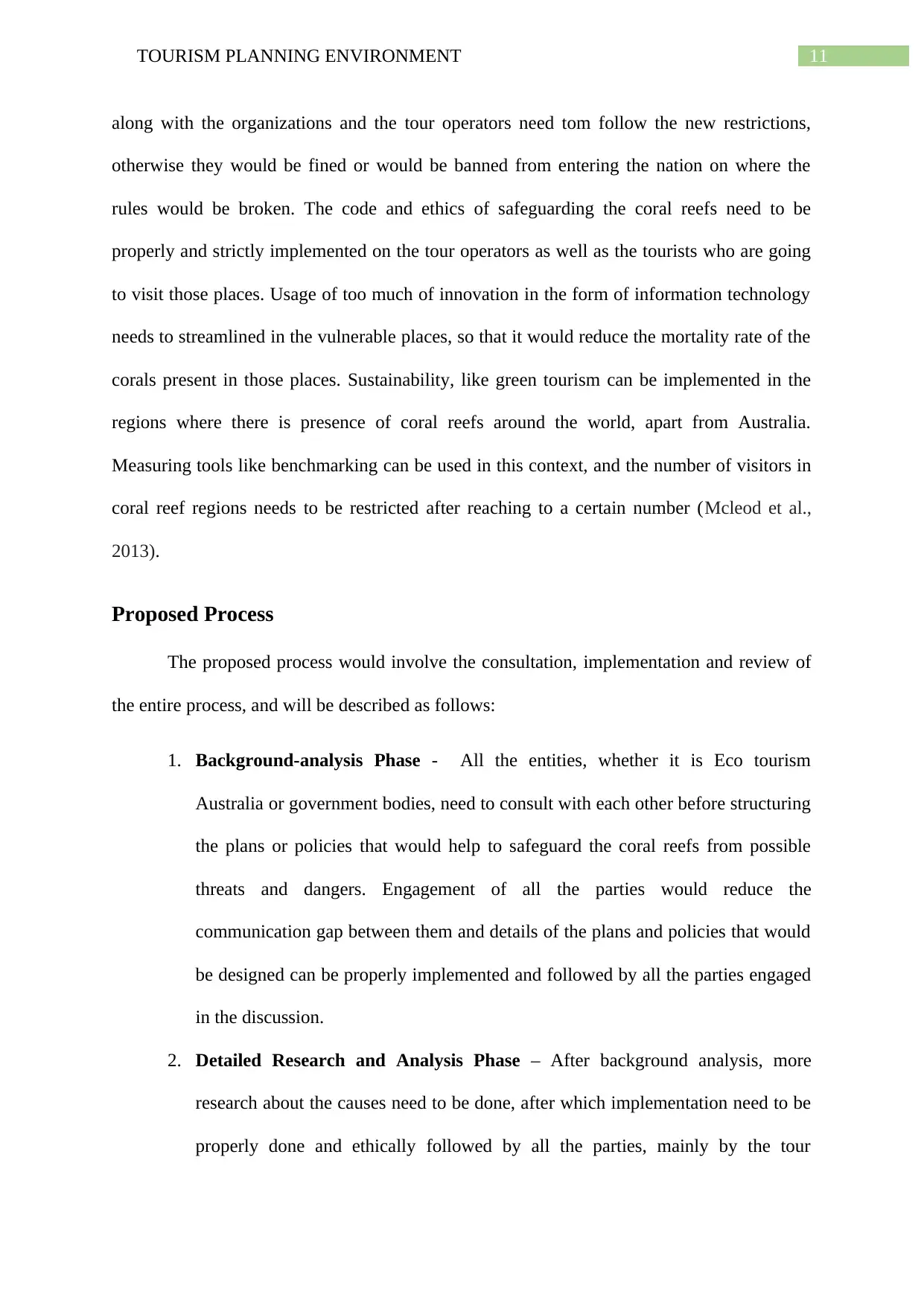
11TOURISM PLANNING ENVIRONMENT
along with the organizations and the tour operators need tom follow the new restrictions,
otherwise they would be fined or would be banned from entering the nation on where the
rules would be broken. The code and ethics of safeguarding the coral reefs need to be
properly and strictly implemented on the tour operators as well as the tourists who are going
to visit those places. Usage of too much of innovation in the form of information technology
needs to streamlined in the vulnerable places, so that it would reduce the mortality rate of the
corals present in those places. Sustainability, like green tourism can be implemented in the
regions where there is presence of coral reefs around the world, apart from Australia.
Measuring tools like benchmarking can be used in this context, and the number of visitors in
coral reef regions needs to be restricted after reaching to a certain number (Mcleod et al.,
2013).
Proposed Process
The proposed process would involve the consultation, implementation and review of
the entire process, and will be described as follows:
1. Background-analysis Phase - All the entities, whether it is Eco tourism
Australia or government bodies, need to consult with each other before structuring
the plans or policies that would help to safeguard the coral reefs from possible
threats and dangers. Engagement of all the parties would reduce the
communication gap between them and details of the plans and policies that would
be designed can be properly implemented and followed by all the parties engaged
in the discussion.
2. Detailed Research and Analysis Phase – After background analysis, more
research about the causes need to be done, after which implementation need to be
properly done and ethically followed by all the parties, mainly by the tour
along with the organizations and the tour operators need tom follow the new restrictions,
otherwise they would be fined or would be banned from entering the nation on where the
rules would be broken. The code and ethics of safeguarding the coral reefs need to be
properly and strictly implemented on the tour operators as well as the tourists who are going
to visit those places. Usage of too much of innovation in the form of information technology
needs to streamlined in the vulnerable places, so that it would reduce the mortality rate of the
corals present in those places. Sustainability, like green tourism can be implemented in the
regions where there is presence of coral reefs around the world, apart from Australia.
Measuring tools like benchmarking can be used in this context, and the number of visitors in
coral reef regions needs to be restricted after reaching to a certain number (Mcleod et al.,
2013).
Proposed Process
The proposed process would involve the consultation, implementation and review of
the entire process, and will be described as follows:
1. Background-analysis Phase - All the entities, whether it is Eco tourism
Australia or government bodies, need to consult with each other before structuring
the plans or policies that would help to safeguard the coral reefs from possible
threats and dangers. Engagement of all the parties would reduce the
communication gap between them and details of the plans and policies that would
be designed can be properly implemented and followed by all the parties engaged
in the discussion.
2. Detailed Research and Analysis Phase – After background analysis, more
research about the causes need to be done, after which implementation need to be
properly done and ethically followed by all the parties, mainly by the tour
⊘ This is a preview!⊘
Do you want full access?
Subscribe today to unlock all pages.

Trusted by 1+ million students worldwide
1 out of 16
Related Documents
Your All-in-One AI-Powered Toolkit for Academic Success.
+13062052269
info@desklib.com
Available 24*7 on WhatsApp / Email
![[object Object]](/_next/static/media/star-bottom.7253800d.svg)
Unlock your academic potential
Copyright © 2020–2025 A2Z Services. All Rights Reserved. Developed and managed by ZUCOL.





